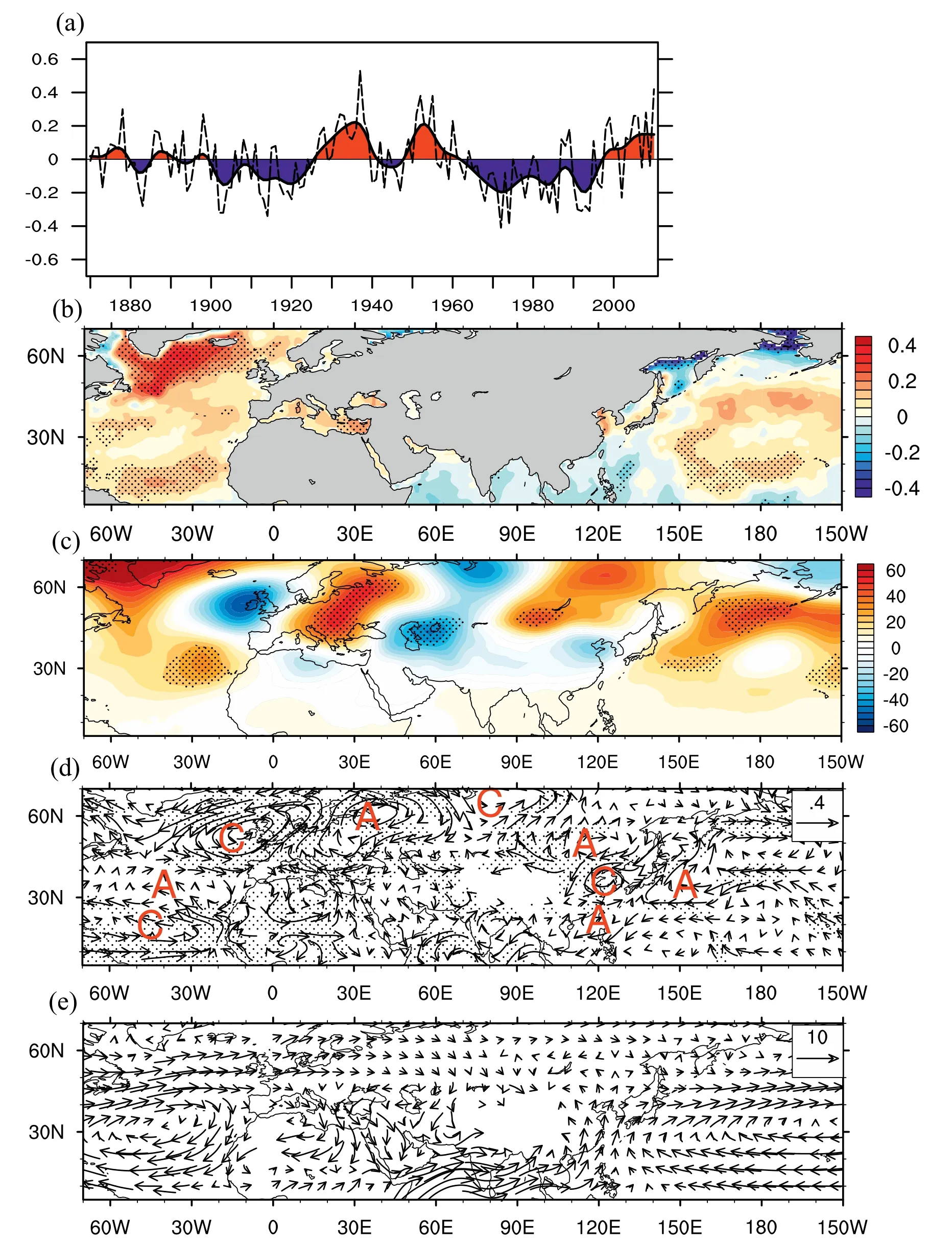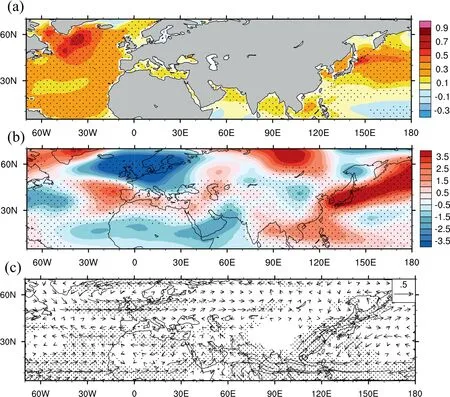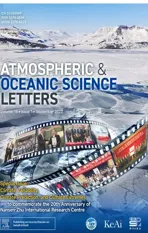Impact of the Atlantic multidecadal variability on East Asian summer climate in idealized simulations
2023-10-11DongSiLiweiYu
Dong Si ,Liwei Yu
a Climate Change Research Center, Institute of Atmospheric Physics, Chinese Academy of Sciences, Beijing, China
Keywords: Atlantic multidecadal variability Idealized simulation East Asian summer climate Sea surface temperature
ABSTRACT The impact of the Atlantic multidecadal variability(AMV)on the East Asian summer climate is analyzed using a set of idealized simulations performed by CESM1.The results show that the AMV exerts a remote impact on the East Asian summer climate via two pathways: a midlatitude Rossby wave train and equatorial Kelvin waves.Specifically,the positive phase of the AMV can enhance the land–sea pressure contrast between the Asian continent and western North Pacific Ocean through the midlatitude Rossby wave train,and induce an anomalous anticyclone in the Northwest Pacific through exciting an equatorial Kelvin wave.These anomalies in atmospheric circulation in turn enhance the East Asian summer monsoon,leading to a northern-wet–southern-dry and warm summer climate in East Asia.
1.Introduction
The variation in sea surface temperature (SST) over the North Atlantic Ocean exhibits prominent multidecadal variability,which is known as the Atlantic Multidecadal Oscillation (AMO;Enfield et al.,2001;Knight et al.,2006).Modeling results show that the AMO-like variations in SST over the North Atlantic are associated with the variation in Atlantic Meridional Overturning Circulation (Delworth and Mann,2000;Knight et al.,2006).However,a growing body of research suggests that the AMO is instead driven by external forcings,including anthropogenic aerosol emissions,solar radiation,and large volcanoes(Booth et al.,2012;Otterå et al.,2010).Recent studies indicate that,during the industrial era,the AMO has been driven by both the internal variability and external forcing (Si and Hu,2017;Qin et al.,2020).Sutton et al.(2018) recommended that “Atlantic multidecadal variability(AMV)”is a more suitable term than the AMO,since the observed multidecadal variations in SST over the North Atlantic exhibit a broader range of low-frequency spectra rather than an oscillation at a single frequency.
The fluctuation of the AMV between positive and negative phases can cause significant climate anomalies in many regions across the globe,including North Africa,Europe,South and East Asia,and North America (Li et al.,2008,2017;Zuo et al.,2013;;Fan et al.,2018;Luo et al.,2018;Yang et al.,2019;Si et al.,2020;Hu et al.,2021;Zhang et al.,2021;Guo et al.,2022).For East Asia,previous research has shown that the positive phase of the AMV results in a strong East Asian summer monsoon through coupled atmosphere–ocean feedbacks over the Indo-western Pacific Ocean(Lu et al.,2006).Moreover,the positive phase of the AMV can increase temperatures in the upper troposphere over the Eurasian continent and further enhance the land–sea thermal contrast between the Asian continent and surrounding oceans,thereby reinforcing the East Asian summer monsoon (Wang et al.,2009).
To gain insight into the impact of the AMV on the East Asian climate during the summer season(June–July–August,JJA),we analyze a set of idealized experiments using the Community Earth System Model,version 1 (CESM1),in which the North Atlantic SSTs are restored to a time-independent spatial pattern corresponding to an estimate of the internal component of the observed AMV anomaly (Ruprich-Robert et al.,2017).Because the aim of the study was to investigate the impacts of internal variability,all experiments used pre-industrial conditions.
2.Data,experiments,and methods
2.1.Data
The following monthly mean observation and reanalysis datasets are used in this study.The monthly mean SST data are from a merged product based on the HadISST dataset from 1870 to 1981 and the OISST dataset from 1981 to 2016 (Hurrell et al.,2008).The global land precipitation data are from the Climate Research Unit(CRU),University of East Anglia,United Kingdom (CRU-TS_3.20),with a horizontal resolution of 0.5◦×0.5◦The surface air temperature(SAT)data are from the University of Delaware’s global SAT dataset,with a horizontal resolution of 0.5◦× 0.5◦The atmospheric circulation data,including geopotential height and horizontal wind,are from NOAA’s 20th Century Reanalysis (V2) dataset for 1871–2012 (NOAA-20C),with a horizontal resolution of 2.5◦× 2.5◦(Compo et al.,2011).
2.2.Experiments
To investigate the impact of the AMV on the East Asian summer climate,a 30-member ensemble of an idealized AMV simulation experiment is analyzed in this study (Ruprich-Robert et al.,2017).The experiment was performed by CESM1.In the experiment,the internally generated component of the observed AMV was separated from the externally forced component,and the idealized AMV pattern was restored (Ting et al.,2009).The externally forced component of the AMV was estimated by applying a signal-to-noise maximizing EOF analysis (Allen et al.,1997;Venzke et al.,1999) to the global annual mean SST derived from the CMIP5 multimodel ensemble.Historical simulations and RCP8.5 simulations were chosen for the periods 1870–2005 and 2006–2013,respectively.The time series associated with the leading global signal-to-noise EOF(EOF1)was taken as the time series of the radiatively forced component of the AMV.The spatial pattern of the forced component of the AMV was obtained by regressing the observed global SST onto the EOF1 time series.Then,the internally generated temporal component of the AMV was obtained from the residuals of the observed SST over the North Atlantic (0◦–60◦N,7.5◦–75◦W) by subtracting the externally forced component.Also,the internally generated AMV spatial pattern was obtained by regressing the residuals of the observed North Atlantic SST against the time series of the internally generated temporal component of the AMV.
The idealized simulations used pre-industrial conditions,i.e.,external forcings were fixed at levels corresponding to the calendar year 1850.The restoring was fully applied in the North Atlantic region(0◦–60◦N,7.5◦–75◦W),while across the rest of the globe the model evolved freely,allowing a full response of the climate system to the AMV-related SST anomalies (Ruprich-Robert et al.,2017).In the negative(positive)AMV experiment,SST anomalies that corresponded to one standard deviation of the AMV index were subtracted from (added to)the climatological SST over the North Atlantic Ocean in the model.
2.3.Methods
The AMV index is defined as the area-weighted average of the JJA SST over the North Atlantic(0◦–60◦N,7.5◦–75◦W),but the global mean SST was removed based on the suggestion of Trenberth and Shea(2006).A low-pass Lanczos filter was applied to the AMV index to filter out its interannual signals.The Monte Carlo method was used to test the significance of regression coefficients.Two-tailed Student’st-tests were used to test the significance of mean differences obtained by composite analysis.
3.Results
Fig.1(a) shows the observed low-pass filtered JJA AMV index.The AMV index shows remarkable interdecadal variability,with positive phases from the 1920s to the early 1960s and from the late 1990s to the 2010s,and negative phases from the 1900s to the 1910s and from the mid-1960s to the 1990s.The observed positive-phase AMV spatial pattern is characterized by a basin-wide warming over the North Atlantic but with relatively lower SST in the midlatitude North Atlantic and higher SST in the tropical and extratropical North Atlantic (Fig.1(b)).Corresponding to the positive phase–like North Atlantic warming,positive SST anomalies can be seen in the extratropical North Pacific,whereas negative anomalies are apparent in the tropical eastern and central Pacific,which resembles the negative phase of the Pacific Decadal Oscillation(PDO).

Fig.1.(a) Observed JJA AMV index.(b) Regression of the observed JJA SST on the observed AMV index from 1871 to 2012,in which values exceeding the 95%confidence level are stippled.(c) As in (b) but for the 500-hPa geopotential height.(d) As in (b) but for the 850-hPa wind.(e) Climatology of JJA 850-hPa wind in summer during 1871–2012.
The AMV exerts a remote impact on East Asian climate through exciting an atmospheric Rossby wave train,which propagates downstream from the North Atlantic to East Asia,thereby serving as a teleconnection between the AMV and East Asian climate (Si and Ding,2016).As shown in Fig.1(c),the wave train pattern includes eight centers of action—namely,over the North Atlantic,western Europe,eastern Europe,Central Asia,Lake Baikal,East Asia,the North Pacific,and North America.During a positive phase of the AMV,anomalous low and high pressure dominates East Asia and the western North Pacific,respectively.The“ocean-high–land-low”pattern of anomalous pressure enhances the land–sea pressure contrast,which eventually intensifies the East Asian summer monsoon.In addition,the high pressure anomaly over the western North Pacific associated with the positive phase of the AMV leads to an enhanced western Pacific subtropical high,which further intensifies the southeasterly monsoon flow and water vapor transport (Zhang and Tao,2003).At lower levels,cyclonic and anticyclonic anomalies alternate from the tropical North Atlantic to the western North Pacific(Fig.1(d));and meanwhile,the climate mean state features two huge subtropical highs dominating the North Atlantic and western North Pacific,with westerly winds prevailing over midlatitude Eurasia (Fig.1(e)).Apparently,this midlatitude wave train pattern is closely associated with the AMV.In the East Asia–western North Pacific region,a cyclonic anomaly is located to the north of the Yangtze River and an anticyclonic anomaly is located over the western North Pacific and South China.The enhanced East Asian summer monsoon results in the northward movement of the summer rain belt in East Asia,showing a“northern-wet–southern-dry” pattern with enhanced rainfall in North China and weakened rainfall over the Yangtze River valley(Fig.2(a)).In terms of the SAT pattern,the positive phase of the AMV increases the SAT over most parts of East Asia through strengthening the northward transport of warm and moist air masses to East Asia (Fig.2(c) and Fig.S1).
For the phase difference,i.e.,the AMV positive phase minus the AMV negative phase,the SST pattern in the North Atlantic is characterized by positive SST anomalies of 0◦C–0.3◦C over the tropical North Atlantic and 0.3◦C–0.6◦C over the extratropical North Atlantic,indicating the positive phase of the AMV(Fig.3(a)).In response to the positive phase of the AMV,a zonal midlatitude Rossby wave train extending from the North Atlantic to the North Pacific is apparent in the idealized simulations,which resembles the observation but with slightly shifted geographical positions of the action centers (Fig.3(b)).Note that the model reproduces well the “ocean-high–land-low” pressure pattern between East Asia and the western North Pacific,and eventually captures the enhanced East Asian summer monsoon in response to the positive AMV–like North Atlantic warming(Fig.3(b,c)).Resulting from this,the observed northern-wet–southern-dry and warm climate in East Asia in response to the positive AMV–like North Atlantic warming is also reproduced by the idealized simulations(Fig.2(b,d)).

Fig.3.(a) Five-year ensemble mean JJA SSTs (units: ◦C) for the positive phase of the AMV minus the negative phase of the AMV simulated by the idealized simulations,in which values exceeding the 95%confidence level are stippled.(b)As in(a)but for 500-hPa geopotential height(units:gpm).(c)As in(a)but for 850-hPa wind (units: m s-1).
In addition to the above midlatitude pathway for the influence of the AMV on the East Asian summer climate,a tropical pathway for this remote impact has also been found.The atmospheric deep convection induced by the positive AMV–like North Atlantic warming leads to anomalous easterly winds over the equatorial Indo-western Pacific Ocean by exciting an equatorial Kelvin wave (Fig.1(d)).The idealized simulations show that the anomalous easterly winds induced by the Kelvin wave increase the SST over the tropical Indo-western Pacific via the wind–evaporation–SST mechanism (Xie and Philander,1994),but decrease the SST over the tropical eastern–central Pacific through the Bjerknes ocean dynamical process (Bjerknes,1969;Li et al.,2016),featuring a La Niña-type response (Fig.3(a,c)).There are significant opposing-sign SST anomalies over the extratropical North Pacific versus the tropical eastern and central Pacific,which resembles the negative phase of the PDO.This result is consistent with previous studies that showed a positive AMV can contribute to a negative phase of the PDO(Si and Ding,2016;Meehl et al.,2021).It is noteworthy that the equatorial Kelvin wave generates divergence in the subtropics and triggers an anomalous anticyclone in the Northwest Pacific (Fig.3(c)).This anomalous anticyclone enhances the northward transport of warm and moist monsoon flow to East Asia,which leads to a northern-wet–southern-dry and warm summer climate in East Asia(Fig.2(b,d)).Since the only forcing in the idealized simulations is the AMV-like SST anomaly in the North Atlantic,the atmospheric and oceanic responses in these simulations can therefore be attributed to the internal component of the AMV.
4.Conclusion
This study investigated the influence of the AMV on the East Asian summer climate by utilizing a set of idealized simulations performed by CESM1.It was found that the AMV is closely related to the variability of summer climate in East Asia.The positive phase of the AMV contributes to an enhanced summer monsoon and northward shift of the summer rain belt in East Asia,featuring a northern-wet–southern-dry and warm East Asian summer climate,and vice versa.It was found that the AMV can exert a remote impact on the East Asian summer climate through two pathways,including a midlatitude Rossby wave train and an equatorial Kelvin wave.For the midlatitude pathway,the SST anomalies over the North Atlantic associated with the AMV excite a Rossby wave train to propagate downstream from the North Atlantic to East Asia,which serves as a teleconnection between the AMV and the East Asian climate.The AMV regulates the land–sea pressure contrast between East Asia and the western North Pacific through the Rossby wave train,which modulates the East Asian summer monsoon.For the tropical pathway,the atmospheric convection generated by the AMV-related North Atlantic SST anomalies excites an equatorial Kelvin wave that extends eastwards,altering the low-level atmospheric circulation in the Northwest Pacific.Specifically,a positive phase of the AMV enhances the land–sea pressure contrast between East Asia and the western North Pacific through the midlatitude pathway and induces an anomalous anticyclone in the Northwest Pacific through the tropical pathway,which enhances the East Asian summer monsoon.The enhanced East Asian summer monsoon leads to a northern-wet–southern-dry and warm summer climate in East Asia.
Funding
This work was supported by the National Natural Science Foundation of China [grant number 41875104].
Supplementary materials
Supplementary material associated with this article can be found,in the online version,at doi:10.1016/j.aosl.2023.100399.
杂志排行
Atmospheric and Oceanic Science Letters的其它文章
- Skill improvement of the yearly updated reforecasts in ECMWF S2S prediction from 2016 to 2022
- Research progress on inter-monthly winter temperature variation in East Asia and climate prediction
- Precursory atmospheric teleconnection patterns for strong Siberian High events
- Distinct impacts of two kinds of El Niño on precipitation over the Antarctic Peninsula and West Antarctica in austral spring
- Contribution of external forcing to summer precipitation trends over the Qinghai—Tibet Plateau and Southwest China
- Impact of the Asian—Pacific Oscillation on early autumn precipitation over Southeast China:CMIP6 evaluation and projection
